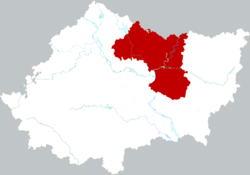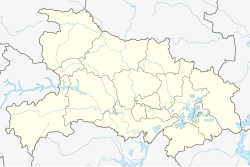Xiangzhou
襄州区 | |
|---|---|
 Location in Xiangyang | |
| Coordinates: 32°05′14″N 112°12′43″E / 32.08722°N 112.21194°E | |
| Country | People's Republic of China |
| Province | Hubei |
| Prefecture-level city | Xiangyang |
| Area | |
• Total | 2,306 km2 (890 sq mi) |
| Population (2020)[2] | |
• Total | 923,235 |
| • Density | 400/km2 (1,000/sq mi) |
| Time zone | UTC+8 (China Standard) |
| Website | hbxy |
| Xiangzhou | |||||||||
|---|---|---|---|---|---|---|---|---|---|
| Chinese | 襄州 | ||||||||
| |||||||||
| Xiangyang (the former city) | |||||||||
|---|---|---|---|---|---|---|---|---|---|
| Traditional Chinese | 襄陽 | ||||||||
| Simplified Chinese | 襄阳 | ||||||||
| Postal | Siangyang | ||||||||
| |||||||||
Xiangzhou District (simplified Chinese: 襄州区; traditional Chinese: 襄州區; pinyin: Xiāngzhōu Qū) is a district of the city of Xiangyang, Hubei, People's Republic of China. The district itself was formerly known as Xiangyang (襄阳区). It was a city famous for the siege of Xiangyang (1267–1273) by invading forces of the Mongol-founded Yuan Dynasty. It was also an important city during the period of the Three Kingdoms, in the Romance of the Three Kingdoms it was said that it was nearby Xiangyang that Zhuge Liang received his three visits from Liu Bei. Xiangyang was also where Sun Jian fought Liu Biao in 191 AD during the Three Kingdoms.[citation needed] Today, Xiangzhou has been incorporated with nearby Fancheng to form the prefecture-level city of Xiangyang, part of Hubei province.
- ^ Cite error: The named reference
govxzwas invoked but never defined (see the help page). - ^ "China: Húbĕi (Prefectures, Cities, Districts and Counties) - Population Statistics, Charts and Map". www.citypopulation.de. Retrieved 2024-11-22.
